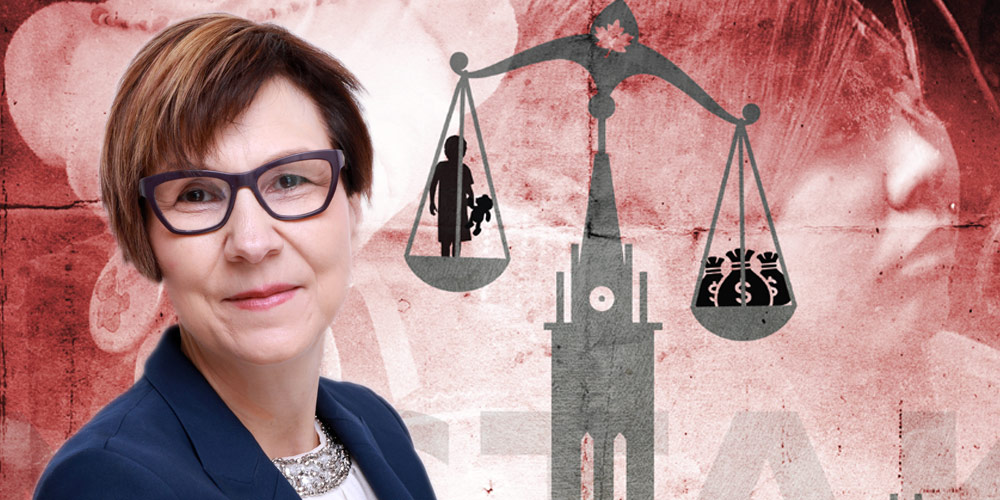
In 1907, Dr. Peter Henderson Bryce, chief medical officer of Canada’s Department of Indian Affairs, authored a report on the outrageous rates of disease and mortality stemming from residential schools in the Prairies. The report, Saturday Night wrote on its front page, “contains information that should startle the country and at last compel the attention of Parliament.”
It did not. Rather, as the magazine feared would happen absent a groundswell of public opinion, the government took no action.
Fifteen years later, shortly after his retirement, Dr. Bryce published a pamphlet, The Story of a National Crime, this time blowing the whistle on not just the prevalence of fatal illness in residential schools but also the government’s official indifference to it.
The system continued for several more decades.
Cindy Blackstock often cites Bryce as a figure banging his head against the same racist wall a full century before she did. Blackstock, the head of the First Nations Child and Family Caring Society and a social work professor at McGill University, was locked in her own 15-year battle with the federal government over the inadequate, unequal funding of First Nations child-welfare services. A resolution was finally reached this past January.
On this week’s CANADALAND, Danielle Paradis talks to Blackstock about her life’s work, and to the legendary documentary-maker Alanis Obomsawin, who chronicled the first decade of the child-welfare case in 2016’s We Can’t Make the Same Mistake Twice:
Here’s an edited excerpt of Blackstock explaining the Canadian government’s long legacy of indifference towards First Nations children:
A hundred years ago, in 1922, just a few blocks away from where I’m speaking to you now in Ottawa, Dr. Peter Henderson Bryce published a manuscript called The Story of a National Crime.
He had been the chief medical health inspector in the Indian Department in 1907 and found that Canada’s unequal healthcare funding and all of the terrible health practices in the schools — including malnutrition, poor sanitation, poor ventilation, all of these things — were creating what he called veritable hotbeds of disease, resulting in close to 50% of the children dying within three years. So he proposed solutions to fix this, like “Give them the proper healthcare funding, stop these terrible health practices. You can save these kids’ lives, Government of Canada.” That would have been Prime Minister Wilfrid Laurier. And the government of Canada chose not to do it.
And he would not be silent. He kept on speaking out. And so his report was leaked to newspapers back in 1907. Articles — “Dying like flies”; “Absolute inattention to bare necessities of health” — throughout national papers across the country. People reading it actually felt back then that Canada’s behaviour could be criminal.
But when the headlines died, Canada kept on doing nothing.
When Bryce, out of frustration in 1922, publishes A National Crime, we see another burst. And the headlines die, and so do the children.
And when we filed this human rights case back in 2007 with the Assembly of First Nations, there were headlines about the inequality, and then there was nothing. And sadly, in the next close-to-a-decade in which Canada fought it on legal technicalities, not only did some children die in ways that were linked to this inequality, others were denied a proper childhood, and families were denied an equitable chance to grow up safely together, because services to recover from multigenerational trauma to prevent children from going into care were completely absent from the federal system.
The inequalities were huge, and they knew it. That’s the other thing: the federal government knows in all of these cases — whether we’re talking about Dr. Bryce or we’re talking about the inequalities that fed this case. They knew it. They knew they were underfunding. They didn’t disagree with that. They also realized the harms were happening to children and the deaths; they agreed on that. They just chose not to do it. And they were able to keep that choice, as long as people were looking the other way.
Where all these things come together is in the whole underpinning of the colonialism, which is a savage/civilized dichotomy. That’s where you dehumanize First Nations, Métis, and Inuit peoples, and that dehumanization legitimizes immoral behaviour by people who proclaim themselves to be superior. And that allows for dispossession of land, dispossession of resources, dispossession of culture, language, and children. That’s the common theme. It creates all of these hardships across the board. And too often we just focus on the symptom without really going to the cause of the problem, which is this racism that has been enfranchised into the Canadian state.
Top image includes a portrait of Blackstock via McGill University, as well as a portion of the poster for We Can’t Make the Same Mistake Twice, via the NFB.